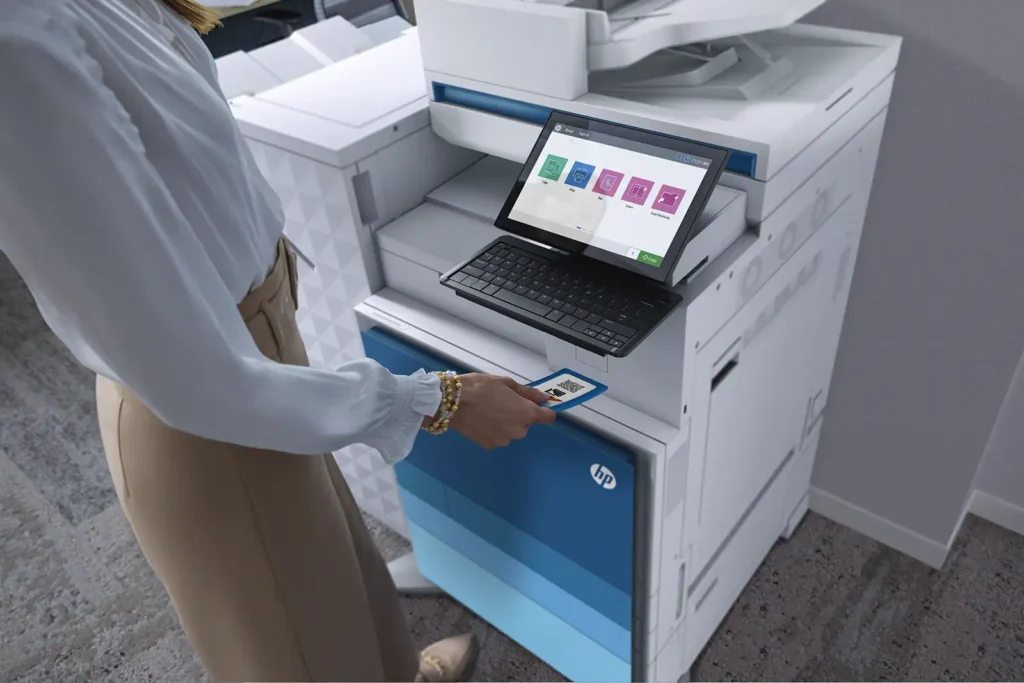Did you know that 60% of UK businesses have experienced a cybersecurity breach through their networked printers? In today’s hybrid work environment, these devices are often overlooked, yet they remain a prime target for cyberattacks. This is where advanced protection steps in, safeguarding your office ecosystem from unseen threats.
As businesses across the UK adapt to hybrid workforces, the need for robust infrastructure protection has never been greater. Modern solutions are designed to address these challenges, offering capabilities like threat containment and self-healing. These innovations ensure your operations remain secure and compliant with UK-specific regulations.
Quocirca’s 2024 findings highlight the growing importance of print security in today’s digital landscape. By integrating cutting-edge technology, businesses can stay ahead of evolving threats while maintaining productivity. Let’s explore how these advancements are reshaping the way we protect our workplaces.
Key Takeaways
- Networked printers are a common target for cyberattacks in the UK.
- Advanced protection is essential for hybrid work environments.
- Modern solutions offer features like threat containment and self-healing.
- UK businesses must prioritise compliance with local regulations.
- Quocirca’s 2024 report emphasises the importance of print security.
Introduction to HP Wolf Security Features
Modern workplaces demand advanced solutions to safeguard critical systems. With cyber threats becoming increasingly sophisticated, businesses need more than just traditional software-based protections. This is where a hardware-enforced architecture comes into play, offering a robust shield against potential breaches.
At the core of this approach is seamless integration with commercial Intel® and AMD CPUs. This ensures that protection is embedded at the hardware level, making it far more resilient to attacks. The system’s core components—Threat Containment, Protect & Trace, and Sure Start—work together to create a multi-layered defence mechanism.
Compatibility with Windows 10/11 Pro is a key requirement, ensuring that businesses can integrate this solution into their existing infrastructure. Additionally, certifications like ISO27001 and SOC2 Type2 highlight its adherence to global standards, providing peace of mind for UK and EU operations.
- Hardware-enforced architecture: Built into the system for enhanced resilience.
- Core components: Threat Containment, Protect & Trace, and Sure Start.
- Windows compatibility: Works seamlessly with Windows 10/11 Pro.
- Certifications: ISO27001 and SOC2 Type2 for global compliance.
- GDPR relevance: Ensures data protection for UK and EU businesses.
Unlike traditional software-only approaches, this full-stack solution covers everything from firmware to applications. This comprehensive strategy ensures that every layer of your system is protected, making it an ideal choice for businesses prioritising advanced safeguards.
Why Office Printers Need Advanced Security
The humble office printer is more than just a device—it’s a gateway for cyber threats. With 70% of organisations experiencing print-related data breaches in 2024, as reported by Quocirca, it’s clear that these machines are a prime target for cybercriminals. Networked printers, often overlooked, can expose businesses to significant risks if not properly secured.
Common Threats to Office Printers
Firmware vulnerabilities in networked printers are a major concern. These weaknesses can be exploited to gain unauthorised access or disrupt operations. Ransomware attacks targeting print job queues are also on the rise, locking businesses out of critical functions until a ransom is paid.
Unauthenticated physical access to printers poses another risk. Employees or intruders can misuse these devices to extract sensitive data. Additionally, printers often serve as entry points for lateral movement within a network, allowing attackers to infiltrate deeper into systems.
The Role of Advanced Solutions in Mitigating Risks
To combat these threats, continuous anomaly monitoring is essential. This approach detects unusual activity in real-time, enabling swift responses to potential breaches. Automatic self-healing mechanisms further enhance resilience by repairing compromised systems without human intervention.
BIOS protection, such as Sure Start, ensures that the printer’s firmware remains secure from tampering. This is particularly crucial in defending against supply chain compromises, where attackers target devices before they even reach the office.
By addressing these vulnerabilities, businesses can safeguard their operations and maintain compliance with UK-specific regulations. The integration of advanced solutions not only protects printers but also strengthens the overall cybersecurity posture of the organisation.
Key HP Wolf Security Features for Printers
In today’s digital landscape, protecting networked devices is no longer optional. Printers, often overlooked, are now at the forefront of cybersecurity discussions. With advanced solutions, businesses can ensure their operations remain secure and efficient.

Threat Containment Technology
One of the standout security features is the ability to isolate suspicious print jobs through sandboxing. This approach ensures that potential threats are contained before they can harm the system. Hardware-enforced micro-virtualisation takes this a step further, operating at the CPU level to block browser-based attacks.
According to recent data, this technology has led to a 94% reduction in ransomware incidents. By addressing vulnerabilities at their source, businesses can significantly lower their risk of cyberattacks. This proactive method is far more effective than traditional reactive antivirus solutions.
Printer Resiliency and Self-Healing
Another critical aspect is the system’s ability to recover from corrupted states automatically. Automatic firmware integrity checks ensure that the device remains secure, even after an attempted breach. This resiliency is further enhanced by features like HP Tamper Lock, which prevents physical tampering.
For UK businesses, these capabilities are particularly valuable. They not only protect sensitive data but also ensure compliance with local regulations. By integrating these advanced solutions, organisations can maintain productivity while staying ahead of evolving threats.
Benefits of HP Wolf Security for Businesses
Businesses today face increasing pressure to safeguard sensitive information while maintaining operational efficiency. With cyber threats evolving rapidly, advanced solutions are no longer a luxury—they’re a necessity. These innovations not only protect critical systems but also enhance overall productivity.
Enhanced Data Protection
One of the most significant advantages is the ability to secure sensitive data effectively. Automated policy enforcement ensures that only authorised users can access critical systems, reducing the risk of breaches. This is particularly crucial for UK businesses, which must comply with GDPR regulations.
Additionally, features like secure erasing during decommissioning ensure that no residual data is left behind. This not only protects against leaks but also extends the hardware lifecycle, offering a strong return on investment.
Improved Operational Efficiency
Advanced solutions also streamline operations, reducing the burden on IT teams. For instance, a case study from Swedish Municipalities reported a 40% reduction in IT support tickets. This allows businesses to focus on core activities rather than troubleshooting.
Moreover, 24/7 protection ensures that systems remain secure without requiring constant user intervention. This leads to faster incident response times—up to 63% quicker, as reported by Masonicare. Such improvements not only enhance efficiency but also build trust with clients and stakeholders.
- Automated policy enforcement reduces unauthorised access.
- Secure erasing ensures no residual data remains.
- 40% fewer IT support tickets reported in Swedish Municipalities.
- 63% faster incident response times, as per Masonicare.
- Extended hardware lifecycle improves ROI.
Real-World Applications of HP Wolf Security
Real-world examples demonstrate the transformative impact of advanced protection in modern workplaces. By examining specific case studies, we can see how these solutions address unique challenges and deliver measurable results. Let’s explore two notable examples: Swedish Municipalities and Masonicare.
Swedish Municipalities: Enhancing Hybrid Workforce Security
The Swedish Municipalities faced significant challenges with their hybrid workforce. Managing a distributed team required robust security solutions to protect sensitive data. By implementing advanced protection, they reduced their breach response time by an impressive 58%.
Key metrics included a 40% reduction in IT support tickets and a significant decrease in the attack surface. This allowed their IT team to focus on strategic initiatives rather than constant troubleshooting. The integration with existing frameworks ensured seamless deployment and compliance with local regulations.
Masonicare: Safeguarding Medical Data
Masonicare, a healthcare provider, needed to protect sensitive patient information. Their primary concern was ensuring compliance with stringent data protection standards. By adopting advanced solutions, they achieved 73% faster recovery times post-incident.
This improvement was crucial for maintaining operational continuity and patient trust. The integration with NHS security frameworks further enhanced their resilience. Video testimonials from the organisation highlight the ease of deployment and the immediate impact on their security posture.
| Metric | Swedish Municipalities | Masonicare |
|---|---|---|
| Breach Response Time Reduction | 58% | 73% |
| IT Support Tickets Reduction | 40% | N/A |
| Integration with Existing Frameworks | Yes | Yes |
These case studies serve as a blueprint for UK public sector adoption. They highlight the importance of advanced protection in addressing modern security challenges. By learning from these examples, businesses can better safeguard their operations and maintain compliance with UK-specific regulations.
How to Implement HP Wolf Security in Your Office
Implementing advanced protection in your office doesn’t have to be complicated. With the right approach, you can ensure your systems are secure and efficient. Let’s explore the essential steps to get started.

System Requirements and Setup
Before diving in, it’s crucial to understand the system requirements. Your hardware must meet minimum specifications to support advanced solutions. This includes ensuring compatibility with Windows 10/11 Pro, which is essential for seamless integration.
Here’s a quick checklist to guide you:
- Verify hardware specifications meet the required standards.
- Install HP TechPulse via hp.com/premium-plus for telemetry configuration.
- Update printer firmware to the latest version for optimal performance.
Best Practices for Printer Security
Once your system is set up, adopting best practices is key to maintaining robust protection. Regular security audits, ideally quarterly, help identify and address vulnerabilities proactively.
Consider these recommendations:
- Implement physical access controls to prevent unauthorised use.
- Conduct employee awareness training to reduce human error.
- Use assessment tools to evaluate and enhance your security posture.
By following these steps, you can create a secure environment that protects your office from evolving threats. Advanced protection isn’t just about technology—it’s about building a culture of awareness and resilience.
Comparing HP Wolf Security with Other Solutions
When it comes to protecting your office, not all solutions are created equal. With cyber threats evolving rapidly, businesses need to understand the differences between hardware-enforced and software-based systems. This comparison will help you make an informed decision for your organisation.
Hardware-Enforced vs Software-Based Protection
Traditional antivirus software relies on signature-based detection, which can struggle against new or unknown threats. In contrast, hardware-enforced systems operate at the CPU level, offering a more robust defence. IDC reports that this approach provides 68% better threat prevention than software-only solutions.
Another key difference is containment. While traditional systems react after a breach, advanced solutions isolate threats in real-time. This proactive approach minimises damage and ensures business continuity.
Total Cost of Ownership and Third-Party Testing
When evaluating security solutions, it’s essential to consider the total cost of ownership. Hardware-enforced systems may have a higher upfront cost, but they reduce long-term expenses by preventing breaches and minimising downtime.
Third-party testing validates these benefits. Forrester’s Zero Trust validation highlights the effectiveness of hardware-enforced protection in modern workplaces. Additionally, cloud management capabilities streamline operations, making it easier to monitor and secure your systems remotely.
- Hardware-enforced systems offer superior threat prevention.
- Containment capabilities minimise damage from breaches.
- Total cost of ownership is lower in the long run.
- Third-party testing confirms the effectiveness of advanced solutions.
- Cloud management enhances operational efficiency.
For UK businesses, these differences are particularly significant. Advanced solutions not only protect sensitive data but also ensure compliance with local regulations. By choosing the right system, you can safeguard your operations and stay ahead of evolving threats.
Future Trends in Printer Security
The future of printer protection is evolving at an unprecedented pace. As businesses adapt to new technologies, the challenges in safeguarding office devices grow more complex. Staying ahead requires not only addressing current risks but also anticipating what’s next.
Emerging Threats and Challenges
One of the most pressing concerns is the rise of IoT-based exploits. Connected devices, including printers, are becoming prime targets for cybercriminals. These attacks can disrupt operations and compromise sensitive data.
Another significant challenge is the potential impact of quantum computing. While still in its early stages, this technology could render traditional encryption methods obsolete. Businesses must prepare for these emerging threats by adopting advanced solutions.
Innovations in Advanced Solutions
To counter these challenges, innovations like AI-driven predictive threat modelling are being developed. These tools analyse patterns to identify potential risks before they materialise. By 2025, such systems are expected to become a cornerstone of device protection.
Autonomous threat hunting is another breakthrough. This feature allows systems to detect and neutralise threats without human intervention. Combined with firmware integrity checks, it ensures devices remain secure even in the face of sophisticated attacks.
- Predict IoT-based printer exploits to stay ahead of cybercriminals.
- Analyse quantum computing risks and adapt encryption methods.
- Detail the roadmap for firmware integrity and autonomous threat hunting.
- Discuss sustainable initiatives to reduce environmental impact.
- Position advanced solutions as a future-proof investment for businesses.
According to TAG Cyber’s 2025 projections, these advancements will redefine how businesses approach device protection. Additionally, the evolution of UK Cyber Essentials ensures that organisations remain compliant while adopting cutting-edge technologies.
Expert Insights on Printer Security
Understanding the evolving landscape of printer protection requires insights from industry leaders. Recent studies and frameworks provide valuable guidance for businesses aiming to stay ahead of cyber threats. Let’s delve into the latest findings and their implications for UK organisations.
Quocirca’s 2024 Print Protection Landscape
Quocirca’s latest report highlights the growing importance of securing printers in hybrid workplaces. With 70% of organisations experiencing print-related breaches, the need for robust solutions is undeniable. The study emphasises the role of advanced technologies in mitigating risks and ensuring compliance.
Key takeaways include the importance of firmware integrity and the rise of IoT-based exploits. Quocirca’s findings align with UK-specific challenges, such as GDPR compliance and the need for scalable solutions. These insights serve as a roadmap for businesses navigating the complexities of modern protection.
Forrester’s Zero Trust Approach
Forrester’s Zero Trust model offers a strategic framework for reducing attack surfaces. Their study reveals a 52% reduction in vulnerabilities when implementing this approach. The 7-step model focuses on verifying every access request, ensuring that only authorised users can interact with critical systems.
For UK businesses, this approach is particularly relevant. It aligns with NCSC guidance and addresses the unique challenges of hybrid work environments. By adopting Zero Trust principles, organisations can enhance their resilience and maintain compliance with local regulations.
- Quocirca’s findings: Highlight the rise of IoT-based exploits and firmware vulnerabilities.
- Forrester’s Zero Trust model: Reduces attack surfaces by 52% and ensures strict access control.
- IDC recommendations: Emphasise the importance of firmware protection for networked devices.
- TAG Cyber’s endpoint matrix: Provides a comprehensive framework for evaluating advanced solutions.
- NCSC guidance: Aligns with Zero Trust principles to address UK-specific challenges.
These expert insights underscore the importance of adopting advanced solutions. By leveraging frameworks like Zero Trust and addressing emerging threats, businesses can safeguard their operations and stay ahead in the ever-evolving landscape of printer protection.
Taking the Next Step with HP Wolf Security
Taking proactive steps to secure your office environment is essential in today’s digital age. Whether you’re exploring new solutions or looking to enhance your current setup, we’re here to guide you every step of the way. Let’s dive into how you can experience these innovations firsthand.
Experience a Live Demonstration
Our live demo offers a comprehensive walkthrough of key functionalities, including a simulation of Threat Containment and recovery processes. This hands-on experience allows you to see how these solutions work in real-time, giving you confidence in their effectiveness.
Here’s what to expect during the session:
- A detailed agenda outlining the demo’s focus areas.
- A 30-minute session tailored to your specific needs.
- Insights into how these solutions integrate with your existing infrastructure.
Get in Touch for More Information
If you’re ready to take the next step, our team is here to assist. We offer dedicated UK technical support and regional sales contacts to ensure you receive personalised guidance. Whether you’re exploring a proof-of-concept or seeking pricing guidance for SMEs, we’ve got you covered.
Key resources include:
- Access to authorised UK partners for seamless implementation.
- Information on government procurement frameworks for public sector organisations.
- A risk-free evaluation process to help you make an informed decision.
Don’t wait to secure your office environment. Request a demo today or contact us to learn more about how we can support your business.
Securing Your Office Printers with HP Wolf Security
Protecting your office ecosystem is no longer just about software—it’s about safeguarding every connected device. With hybrid workforces becoming the norm, ensuring robust security for your printers is essential. These devices, often overlooked, are critical to maintaining operational integrity.
Advanced solutions offer key differentiators, such as real-time threat containment and self-healing capabilities. These features not only protect your infrastructure but also position it as a strategic investment for the future. Regular security audits are a must to stay ahead of evolving threats.
As UK cybersecurity regulations continue to tighten, compliance is non-negotiable. Our solutions align with GDPR standards, ensuring your data remains protected. Endorsements from case study participants highlight the effectiveness of these measures in real-world scenarios.
Looking ahead, adopting future-ready technologies will keep your business resilient. Don’t wait—take the first step towards securing your office environment today.
FAQ’s
What is HP Wolf Security?
It’s a suite of advanced protection tools designed to safeguard devices like printers and PCs from cyber threats, ensuring business operations remain secure.
Why do office printers need advanced security?
Printers are often overlooked as entry points for cyberattacks. Advanced security mitigates risks like data breaches and malware infections.
How does HP Wolf Security protect printers?
It uses threat containment technology and self-healing capabilities to isolate and neutralise risks, keeping devices resilient against attacks.
What are the benefits for businesses?
Enhanced data protection, improved operational efficiency, and reduced downtime due to cyber incidents.
Can HP Wolf Security be compared to traditional antivirus?
Yes, but it goes beyond by offering proactive threat containment and device-level protection, making it more robust for modern cyber challenges.
What are the system requirements for implementation?
It requires Windows Pro or higher for optimal functionality, ensuring compatibility with enterprise-level security needs.
Are there real-world examples of its effectiveness?
Yes, organisations like Swedish Municipalities and Masonicare have successfully implemented it to enhance their security posture.
What future trends does HP Wolf Security address?
It focuses on emerging threats like zero-day attacks and integrates innovations to stay ahead in the evolving cybersecurity landscape.
How can I learn more or request a demo?
Visit our website to contact us or request a demo to see how it can protect your business.


